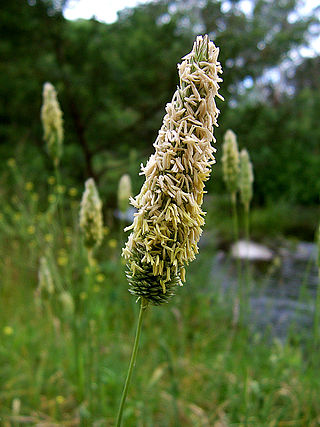
Poaceae or Gramineae is a large and nearly ubiquitous family of monocotyledonous flowering plants commonly known as grasses. It includes the cereal grasses, bamboos and the grasses of natural grassland and species cultivated in lawns and pasture. The latter are commonly referred to collectively as grass.

Wild rice, also called manoomin, mnomen,Canada rice, Indian rice, or water oats, is any of four species of grasses that form the genus Zizania, and the grain that can be harvested from them. The grain was historically gathered and eaten in both North America and China, but eaten less in China, where the plant's stem is used as a vegetable.

Metroxylon sagu, the true sago palm, is a species of palm in the genus Metroxylon, native to tropical southeastern Asia. The tree is a major source of sago starch.
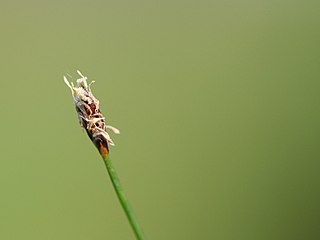
Eleocharis acicularis is a species of spikesedge known by the common names needle spikerush and least spikerush. It is widespread across Europe, central and southeastern Asia, North America and northeastern South America as far south as Ecuador. It is also found in Australia, where it is probably an introduced species.
Eleocharis atropurpurea is a species of spikesedge known by the common name purple spikerush. This is an aquatic plant native to much of. It also has a wide distribution in temperate regions of North and South America and Asia. It is present in Europe, where it may be an introduced species for the most part.
Eleocharis geniculata is a species of spikesedge known by several common names, including bent spikerush and Canada spikesedge. This is a widespread plant of wet areas in the Americas, Asia, Africa, Australia, Madagascar, and some Pacific Islands. It is an annual spikesedge growing to a maximum height of about 40 centimeters. It has a few straw-colored leaves and many thin erect stems. The stems hold inflorescences of rounded spikelets each containing at least 10 tiny flowers. The flowers are covered with dark greenish-brown bracts. The fruit is a shiny purple-brown achene not more than a millimeter long.
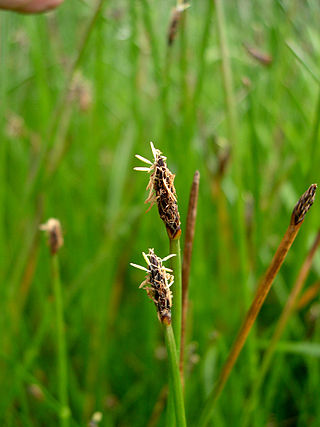
Eleocharis macrostachya is a species of spikesedge known by the common name pale spikerush.

Eleocharis pachycarpa is a species of spikesedge known by the common name black sand spikerush. This plant is native to southern South America but it grows in other parts of the world as an introduced species, such as Australia and the US states of California and Nevada.

Eleocharis quinqueflora is a species of spikesedge known by the common names fewflower spikerush and few-flowered spike-rush. It is widespread across Europe, North Africa, northern Asia, and North America. There are also isolated populations in Argentina and Chile.
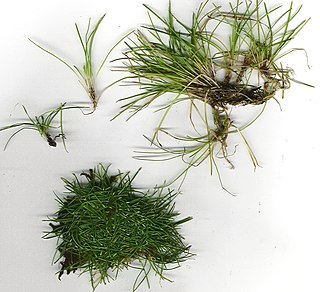
Eleocharis radicans is a species of spikesedge known by the common name rooted spikerush. This aquatic or semi-aquatic plant is native to the Americas as far north as Virginia and northern California. It grows in wet places such as streams, lakes, bogs, and moist meadows, where it roots on soaked ground or floats in the water. This is a rhizomatous, mat-forming perennial with thread-thin, spongy stems. It may have several thin leaves. The stems are topped with papery spikelets about half a centimeter long at maximum size and containing 4 to 12 flowers, each covered with a light-colored bract. The fruit is a minute white or yellow achene less than a millimeter long.
Eleocharis bolanderi, commonly known as Bolander's spikerush, is a species of spikesedge. It is native to the western United States from Colorado west to Oregon and California. It grows in wet spots in several types of habitat, including mountain meadows and springs. It is a rhizomatous perennial herb producing erect, hairless stems 10 to 30 centimeters tall. The narrow, wispy leaves often have purple or reddish speckles and purplish tinting around the bases. The inflorescence is an oval-shaped spikelet at the tip of the stem under a centimeter long and made up of several dark brown, sometimes purple-tinged flowers.
Eleocharis montevidensis is a species of spikesedge known by the common name sand spikerush. It is a widespread coastal plant native to the Americas. It grows in moist, sandy spots in many habitat types, including lakes, riverbanks, wet meadows, and springs. It has a disjunct distribution, in North America and South America.

Eleocharis parishii is a species of spikesedge known by the common name Parish's spikerush.

Eleocharis parvula is a species of spikesedge known by the common names dwarf spikerush, small spikerush and hairgrass in aquaria. It is a plant of brackish and saltwater habitat, such as marshes and mudflats. It is a perennial herb growing tufts of spongy, compressible stems not more than 10 centimeters tall. The plant grows from a tuber which is J-shaped or horseshoe-shaped, a characteristic that helps in the identification of the species. The inflorescence is an oval-shaped spikelet just 2 or 3 millimeters long, made up of several tiny flowers.

Eleocharis quadrangulata is a species of spikesedge known by the common names square-stem spikerush and four-angled spikerush. It is native to eastern and central North America, with additional populations in California, Oregon, and west-central Mexico. It grows in and around freshwater in lakes, ponds, and other bodies of water. It is a rhizomatous perennial herb growing one half to one meter in height. The spongy, compressible stem is a few millimeters wide and sharply four-angled. The inflorescence is a single spikelet 1.5 to 7.5 centimeters long which is made up of several flowers covered in light brown bracts.

Eleocharis rostellata is a species of spikesedge known by the common name beaked spikerush. It is widespread across North America, with isolated populations in Argentina.

Chilo suppressalis, the Asiatic rice borer or striped rice stemborer, is a moth of the family Crambidae. It is a widespread species, known from Iran, India, Sri Lanka, China, eastern Asia, Japan, Taiwan, Malaysia to the Pacific.
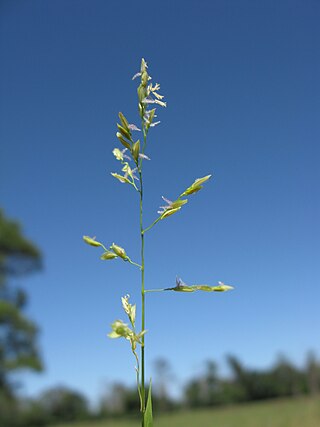
Leersia hexandra is a species of grass known by the common names southern cutgrass, clubhead cutgrass, and swamp rice grass. It has a pantropical distribution. It is also an introduced species in many regions, sometimes becoming invasive, and it is an agricultural weed of various crops, especially rice. It is also cultivated as a forage for livestock.
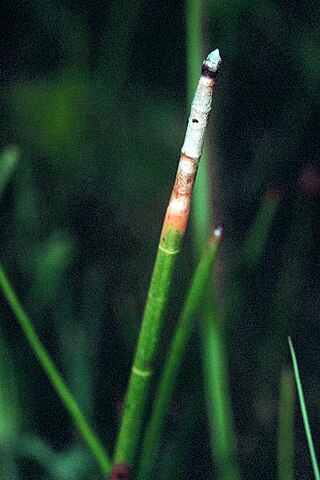
Eleocharis equisetoides, with common names including horsetail spike-rush, jointed spike-rush, spikesedge, and knotted spike-rush, is a plant species native to the United States and Ontario, usually in freshwater wetland areas. It is known primarily from the Atlantic coastal plain from Texas to Massachusetts, and the Great Lakes region, with scattered populations elsewhere.

Eleocharis bifida is a species of spikesedge known by the common name glade spikerush. It is native to the Eastern United States, where it is endemic to the Interior Low Plateau and very small part of the Ridge and Valley ecoregions. This is mostly in Kentucky and Tennessee, extending into southern Indiana, northern Alabama, and northwestern Georgia. It is found only in wet areas in cedar glades, such as pools and streamsides. This narrow habitat requirement is the reason for it being considered vulnerable.
















